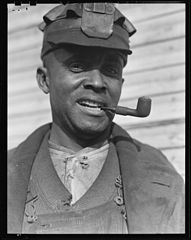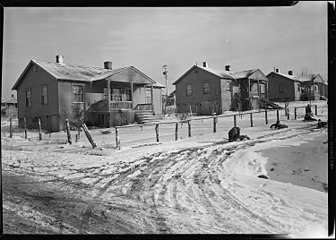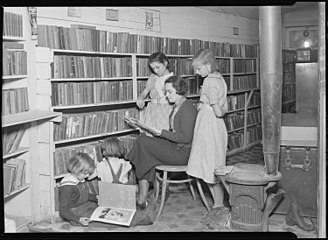
Latimer County is a county located in the southeastern part of the U.S. state of Oklahoma. Its county seat is Wilburton. As of the 2020 census, the population was 9,444. The county was created at statehood in 1907 and named for James L. Latimer, a delegate from Wilburton to the 1906 state Constitutional Convention. Prior to statehood, it had been for several decades part of Gaines County, Sugar Loaf County, and Wade County in the Choctaw Nation.

The Virginian Railway was a Class I railroad located in Virginia and West Virginia in the United States. The VGN was created to transport high quality "smokeless" bituminous coal from southern West Virginia to port at Hampton Roads.

William Nelson Page was an American civil engineer and industrialist. He was active in the Virginias following the U.S. Civil War. Page was widely known as a metallurgical expert by other industry leaders and investors as well as state and federal authorities.
The history of coal mining goes back thousands of years, with early mines documented in ancient China, the Roman Empire and other early historical economies. It became important in the Industrial Revolution of the 19th and 20th centuries, when it was primarily used to power steam engines, heat buildings and generate electricity. Coal mining continues as an important economic activity today, but has begun to decline due to the strong contribution coal plays in global warming and environmental issues, which result in decreasing demand and in some geographies, peak coal.
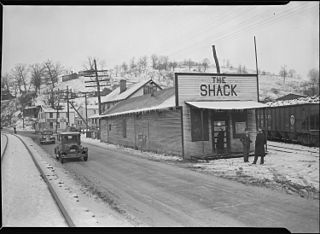
The Shack Neighborhood House serves the people of the once-thriving Appalachian coal mining community of Scotts Run, northwest of Morgantown, West Virginia. Founded by Mary E. Behner in the tradition of the settlement house movement, "The Shack" continues to serve their social, educational, recreational, economic, and health needs.

A coal town, also known as a coal camp or patch, is a type of company town or mining community established by the employer, a mining company, which imports workers to the site to work the mineral find. The company develops it and provides residences for a population of miners and related workers to reside near the coal mine. The 'town founding' process is not limited to mining, but this type of development typically takes place where mineral wealth is located in a remote or undeveloped area. The company opens the site for exploitation by first, constructing transportation infrastructure to serve it, and later to establish residences for workers. Mineral resources were sometimes found as the result of logging operations that established clear-cut area. Geologists and cartographers could then chart and plot the lands for exploitation.

Arthurdale is an unincorporated community in Preston County, West Virginia, United States. It was built in 1933 at the height of the Great Depression as a social experiment to provide opportunities for unemployed local miners and farmers. Arthurdale was undertaken by the short-lived Subsistence Homesteads Division and with the personal involvement of First Lady Eleanor Roosevelt, who used her influence to win government approval for the scheme.

The South Wales Coalfield extends across Pembrokeshire, Carmarthenshire, Swansea, Neath Port Talbot, Bridgend, Rhondda Cynon Taf, Merthyr Tydfil, Caerphilly, Blaenau Gwent and Torfaen. It is rich in coal deposits, especially in the South Wales Valleys.

The Farmington Mine disaster was an explosion that happened at approximately 5:30 a.m. on November 20, 1968, at the Consol No. 9 coal mine north of Farmington and Mannington, West Virginia, United States.
Colliers is an unincorporated community in Brooke County, West Virginia, United States. It is the second oldest town in Brooke County, Wellsburg being the oldest. Its population expanded steadily throughout the 1800s and into the 1900s because a section of the Pittsburgh, Cincinnati, Chicago, and St. Louis (PCC&StL) Railroad ran through the town, and because numerous coal mines were established, including the Blanch Coal Mine and the Locust Grove Mine. After both enterprises closed, the population declined until Colliers became a small, residential community. Throughout its existence, Colliers’ social life has revolved primarily around the local schools and churches.

The Battle of Blair Mountain was the largest labor uprising in United States history and is the largest armed uprising since the American Civil War. The conflict occurred in Logan County, West Virginia, as part of the Coal Wars, a series of early-20th-century labor disputes in Appalachia.

The West Virginia coal wars (1912–1921), also known as the mine wars, arose out of a dispute between coal companies and miners.
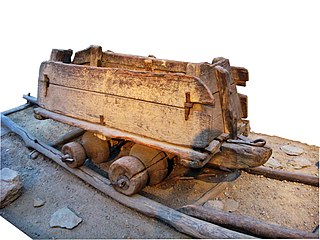
A minecart, mine cart, or mine car is a type of rolling stock found on a mine railway, used for transporting ore and materials procured in the process of traditional mining. Minecarts are seldom used in modern operations, having largely been superseded in underground operations by more efficient belt conveyor systems that allow machines such as longwall shearers and continuous miners to operate at their full capacity, and above ground by large dumpers.
Calumet is a census-designated place in Mount Pleasant Township, Westmoreland County, Pennsylvania, United States. Although the United States Census Bureau included it as a census-designated place with the nearby community of Norvelt for the 2000 census, they are in reality two very different communities, each reflecting a different chapter in how the Great Depression affected rural Pennsylvanians. As of the 2010 census, Calumet-Norvelt was divided into two separate CDPs officially. Calumet was a typical "patch town," another name for a coal town, built by a single company to house coal miners as cheaply as possible. The closing of the Calumet mine during the Great Depression caused enormous hardship in an era when unemployment compensation and welfare payments were nonexistent. On the other hand, Norvelt was created during the depression by the US federal government as a model community, intended to increase the standard of living of laid-off coal miners.
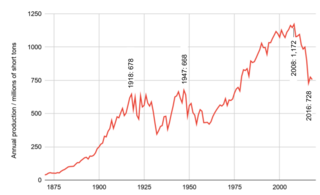
The history of coal mining in the United States starts with the first commercial use in 1701, within the Manakin-Sabot area of Richmond, Virginia. Coal was the dominant power source in the late 1800s and early 1900s, and although in rapid decline it remains a significant source of energy in 2023.

Pursglove is an unincorporated community in Monongalia County, West Virginia, United States and one of the communities that make up the Scotts Run region. Pursglove is located on U.S. Route 19, 4.5 miles (7.2 km) northwest of downtown Morgantown. Pursglove has a post office with ZIP code 26546.

The Subsistence Homesteads Division of the United States Department of the Interior was a New Deal agency that was intended to relieve industrial workers and struggling farmers from complete dependence on factory or agricultural work. The program was created to provide low-rent homesteads, including a home and small plots of land that would allow people to sustain themselves. Through the program, 34 communities were built. Unlike subsistence farming, subsistence homesteading is based on a family member or members having part-time, paid employment. However the new residents were not allowed to purchase the new homes.
The Benwood Mine Disaster was a coal mine explosion that occurred on Monday, April 28, 1924, at the Benwood Mine of the former Benwood Works of Wheeling Steel Corporation located in the city of Benwood in Marshall County, West Virginia. The disaster claimed the lives of 119 coal miners. There were no survivors. It is the third worst coal mining disaster in the state of West Virginia after the Monongah Mine disaster of December 6, 1907, that claimed the lives of 361 miners and the Eccles Mine Disaster of April 28, 1914, that claimed the lives of 183 miners.

The Coal Wars were a series of armed labor conflicts in the United States, roughly between 1890 and 1930. Although they occurred mainly in the East, particularly in Appalachia, there was a significant amount of violence in Colorado after the turn of the century.
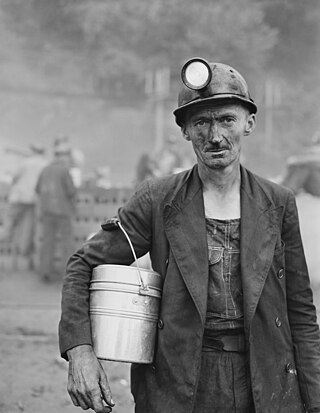
People have worked as coal miners for centuries, but they became increasingly important during the Industrial revolution when coal was burnt on a large scale to fuel stationary and locomotive engines and heat buildings. Owing to coal's strategic role as a primary fuel, coal miners have figured strongly in labor and political movements since that time.








